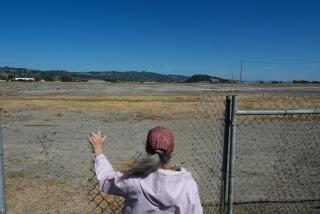Uranium Waste Called a ‘Time Bomb’
WASHINGTON — A huge pile of uranium mill tailings near the Colorado River in Utah is a “radioactive time bomb” that must be moved to protect drinking water for Nevada, Arizona and Southern California, a water official told lawmakers Friday.
But federal regulators said the 10.5 million tons of radioactive and toxic waste near Moab, Utah, doesn’t pose a significant threat to the Colorado River drinking water used by about 25 million people.
The waste pile was left over from more than two decades of uranium processing--mostly by the now-bankrupt Atlas Corp.--which ended in 1984. The federal Nuclear Regulatory Commission has approved the company’s plans to cover the pile with clay and rock, and is working on plans to treat contaminated underground water that flows from the waste 750 feet to the river.
Critics, including Rep. Chris Cannon (R-Utah), who represents the area, say leaving the waste in place is too dangerous. A flood, earthquake or other disaster could send millions of tons of it into the river, they say.
Cannon and Rep. George Miller (D-Martinez) have introduced parallel bills in the House to force the federal government to move the waste to a plateau 18 miles away.
Supporting that idea are Utah officials and the Metropolitan Water District of Southern California, which draws water from the Colorado River for the Los Angeles area.
“We feel there is no choice but to move it,” said Mark Beuhler, the district’s water quality director. “There is nothing like radioactive material in their drinking water to make the public upset.
“It’s a ticking radioactive time bomb,” he said.
Moving the waste would cost more than $100 million, say the NRC and Atlas. The company estimates capping the waste would cost about $20 million.
“Money should not be driving this; it should be public health,” Beuhler argued, noting that water treatment plants cannot remove uranium, which has been proven to cause cancer.
However, NRC and Environmental Protection Agency officials said water treatment plants downstream from the Atlas site have not detected unsafe levels of any toxin from the waste pile.
And Joe Holonich of the NRC said the toxic ground water flowing from beneath the waste pile will continue to do so even if the waste is removed.
“It’s not like a faucet you can turn off,” he said.
The large volume of water in reservoirs such as Lake Mead is enough to safely dilute waste from the Atlas site, said Holonich and Max Dodson of the EPA.
More to Read
Sign up for Essential California
The most important California stories and recommendations in your inbox every morning.
You may occasionally receive promotional content from the Los Angeles Times.










